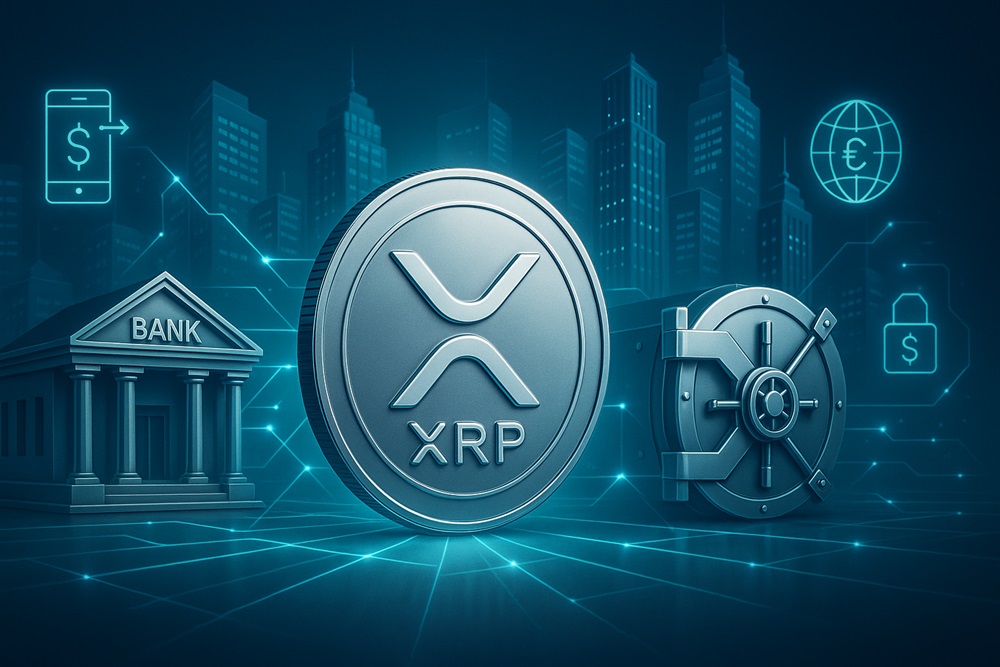Why XRP is Called the Banker’s Coin
XRP has long carried the reputation of being the “banker’s coin”. Unlike Bitcoin, which was designed to operate outside traditional finance, XRP has positioned itself closer to the financial system. With its focus on fast cross-border settlements and its strong links to banks and remittance providers, XRP stands apart in the cryptocurrency ecosystem. But what exactly does this nickname mean, and how does it impact XRP’s role in global finance?
What Is XRP?
XRP is the native token of the XRP Ledger, a blockchain created to improve the efficiency of cross-border payments. Unlike proof-of-work systems such as Bitcoin, the XRP Ledger uses a consensus protocol that allows transactions to finalize in seconds. It was designed not as a decentralized rebellion against banks but as a tool to help financial institutions move money faster and cheaper.

Today, XRP sits among the top cryptocurrencies by market capitalization. For investors following the market, monitoring the XRP price USD helps provide context for its volatility and growth potential. As regulations evolve in the United States and other English-speaking markets, XRP’s price often reflects broader shifts in crypto policy, lawsuits, and adoption.
The Origins of the ‘Banker’s Coin’ Label
The name “banker’s coin” comes largely from Ripple Labs’ involvement. Ripple created the XRP Ledger and pre-mined its 100 billion tokens. A significant portion remains in Ripple’s control, held in escrow and released periodically. This structure contrasts with Bitcoin’s mining-based distribution, which is slower and decentralized.
Ripple Labs focused heavily on working with traditional finance, particularly banks and payment providers. While many cryptocurrencies marketed themselves as anti-bank, Ripple sought to integrate blockchain into the existing system. By offering efficiency upgrades rather than disruption, it attracted financial institutions and drew the banker’s coin nickname.
Why Banks Like XRP
● Speed and Settlement: XRP transactions settle within 3–5 seconds, compared to the days it can take for traditional cross-border transfers through systems like SWIFT.
● Low Costs: The average XRP transaction costs fractions of a cent, which is a major improvement over correspondent banking fees. For banks handling millions of transactions, these savings add up.
● Scalability: The XRP Ledger processes thousands of transactions per second, making it suitable for large-scale institutional use.
● Adoption: RippleNet, Ripple’s payment network, has been adopted by major banks such as Santander, CIBC, and SBI Remit. For these institutions, XRP acts as a bridge currency, enabling instant settlement between different fiat currencies.
This utility explains why banks, rather than resisting XRP, have experimented with and adopted it for cross-border settlement services.
Centralization Concerns
Despite its advantages, XRP has faced ongoing criticism over centralization. Ripple Labs’ large holdings, combined with its role in validating transactions, make many observers argue that XRP is not as decentralized as Bitcoin or Ethereum.
Consensus model: The XRP Ledger uses a system of trusted validators, known as the Unique Node List (UNL). While anyone can run a node, Ripple publishes a recommended validator list. This raises concerns that Ripple holds significant influence over the network’s governance.
Token distribution: With Ripple controlling billions of XRP tokens, critics argue it has the ability to affect the market. The company has attempted to mitigate this perception by using an escrow system, which limits the amount of XRP it can release at any given time. Still, the centralization debate persists.
For regulators, particularly in the United States, this centralization issue has been central to XRP’s legal challenges. The SEC lawsuit against Ripple questioned whether XRP should be considered a security, highlighting the overlap between corporate control and cryptocurrency use.
The Growth Outlook for XRP
Market analysts remain divided on XRP’s long-term trajectory. Optimists point to its strong banking partnerships, expanding adoption, and suitability for global remittances. Some forecasts suggest XRP’s market capitalization could reach into the trillions if widespread adoption occurs.
However, risks remain. Regulatory uncertainty, especially in the United States, has created volatility for XRP. For instance, SEC actions have significantly influenced XRP’s price movements. While Ripple has scored legal victories, the outcome of ongoing cases will shape XRP’s future role in global finance.
In addition, competition is intensifying. Other blockchain networks and stablecoins are moving into the cross-border payment space. Stablecoins like USDC already provide low-cost, fast settlement options, and central bank digital currencies (CBDCs) could further reshape the landscape.
Risk Considerations
Investors should understand both the potential and the risks associated with XRP. Key points include:
● Regulatory risk: XRP’s legal status remains under scrutiny in the United States and abroad. Future rulings could impact adoption.
● Market volatility: Like most cryptocurrencies, XRP experiences sharp price swings. Monitoring real-time prices, such as the XRP price, is important for risk management.
● Competition risk: XRP faces challenges from other blockchain technologies and payment solutions.
● Centralization risk: Ripple’s influence over XRP remains a point of criticism, which could affect institutional trust.
These risks underline the need for caution. While XRP shows promise, it should not be seen as a guaranteed investment opportunity. This article is for informational purposes only and does not constitute financial or investment advice.
Conclusion: Is XRP Really the Banker’s Coin?
XRP has earned the label of the banker’s coin due to its design, purpose, and adoption by major financial institutions. Ripple Labs’ direct involvement with banks and its significant control over XRP’s supply have reinforced the association. At the same time, XRP’s speed, low costs, and scalability make it uniquely suited for cross-border settlements.
Still, its centralized structure, ongoing regulatory challenges, and market volatility prevent it from being a universally trusted solution. To some, it represents a bridge between traditional finance and blockchain. To others, it stands as a reminder that decentralization remains a spectrum rather than an absolute.
In the end, whether XRP thrives will depend on how regulators, banks, and markets continue to respond. One thing is certain: as long as financial institutions seek efficiency, XRP will remain central to the discussion of blockchain’s role in the future of payments.





